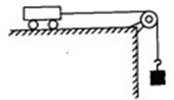问题
选择题
如图所示,小车处在水平桌面上,用轻绳跨过定滑轮与钩码相连,在轻绳的拉力作用下沿桌面做匀速运动.若突然剪断轻绳,则小车( )

A.将继续向前匀速运动
B.运动将越来越慢
C.将立即停止运动
D.受的摩擦力将不变
答案
BD
题目分析:A.剪断轻绳,小车失去拉力作用,由于惯性将将继续向前但减速,故A错误;
B.由于受到摩擦力,又失去拉力,所以运动将越来越慢,故B正确;
C.由于惯性不会立即停止运动,故C错误;
D.由于小车的重不变,压力不变,接触面的粗糙程度也不变,所以小车受的摩擦力将不变,故D正确。
故选BD。
点评:主要考查了惯性的知识,关键是D选项要明确影响摩擦力的因素都没有改变,所以摩擦力不变。



